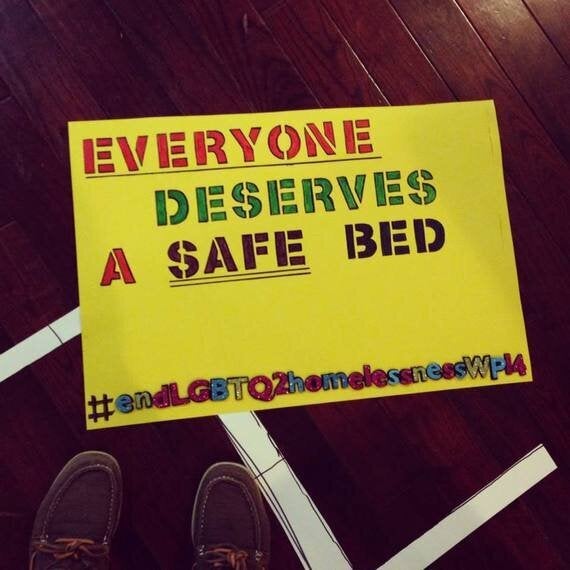On March 11, 2015, Toronto City Council finally approved funding for lesbian, gay, bisexual, transgender, queer, questioning, and 2-spirit (LGBTQ2S) youth transitional housing. The YMCA's Sprott House in Toronto will operate Canada's first LGBTQ2S transitional housing program. I am honoured to be among a group of community organizers and advocates working closely in partnership with the YMCA on the development of this historic program.
For those of you who still need to be convinced that we need such programs, or for those of you who may not necessarily understand the severity of the problem, let me explain...

LGBTQ2S youth homelessness is an emergency situation across Canada, period.
Twenty five to 40 per cent of homeless youth identify as LGBTQ2S. This statistic was reported in one Canadian study 15 years ago, and there is minimal clarity or understanding what this number looks like today or how we would measure the prevalence of LGBTQ2 youth homelessness, when shelters, support services, and point in time counts rarely collect data on youths' gender and sexual identities.
The limited research that has investigated homophobia in Toronto's shelter system over the past two decades has consistently found overrepresentation of LGBTQ2S homeless youth. In recent years, we have come to understand that transgender youth, especially young transgender women of colour, are often the most underrepresented people in the shelter system. Young transgender women of colour frequently experience greater levels of discrimination because they are dealing with transphobia, racism, and oftentimes, homophobia all at once. The intersection of oppressions is very real for this population of young people, because it is such a diverse community, and youth are often oppressed on numerous levels.
This issue has been neglected in important dialogue on youth homelessness in Canada until recently, and still, key decision makers have specified the need for more evidence in order to implement changes to existing services and policies, as well as to develop new programs. It has taken years of community advocacy, research, creative knowledge mobilization, and downright activism in order to provide the necessary evidence to move forward.
For close to a decade I have been addressing the issue of LGBTQ2S youth homelessness. Over the years, my research has focused on the experiences that LGBTQ2S youth have in shelters, support services, and mental health services; what is sustaining homophobia and transphobia in the shelter system; how homophobia and transphobia occurs and is managed in shelters; and how broader policy issues serve to create oppressive contexts for LGBTQ2S youth. My research has ultimately focused on the denial of home and safety to queer and trans youth.
The findings of my research suggest that service providers offering support to homeless youth are not prepared to deal with homophobic and transphobic situations due to a lack of training, and in some circumstances, willful ignorance. The floor that a person will be placed on in a shelter has more to do with the staff's perception of a person's sex and less to do with how an individual actually identifies. Factors such as institutional erasure, homophobic and transphobic violence that is rarely dealt with, and discrimination make it difficult for LGBTQ2S youth to access shelters, therefore, queer and trans youth often feel safer on the streets than in shelters and support services. My research has demonstrated the dire need for the creation of specialized services and safe spaces for LGBTQ2S youth experiencing homelessness, for stricter policies against homophobia and transphobia in the shelter system, and for more discussions of inclusion and acceptance amongst shelter providers and workers.
Although I am extremely disappointed that LGBTQ2S youth homelessness has been inadequately addressed for so many years, I am grateful that there is more understanding and awareness of this social justice crisis. I am also grateful that more organizations are now committed to developing campaigns and programs for LGBTQ2S youth experiencing homelessness.
This issue can no longer be denied. Our youth can no longer be silenced and ignored.
With all of my heart, I hope that this is the beginning of a major shift to how we deal with youth homelessness and that with this shift, more emphasis will be placed on longer term solutions and prevention, with the goal of ending LGBTQ2S youth homelessness in Canada.
For now, may we celebrate this major victory and continue the important fight for the rights and safety of our youth.
I would like to conclude with the powerful words of a brave young person that I interviewed:
"Everybody seems to be down and when we have these pressures [homophobia], well guess what? Now people have to guard themselves all the time. That guy's crying, this girl's crying, that kid looks so sad, this kid just wants to talk to somebody, that kid's dying on the inside. It's a big problem. There's a big social thing going on here with all the kids and they're all dying to just talk to somebody. [...] A community would look like people looking out for the best interests of kids; that's a community. I'm Native, we know that. It's about the kids; it's not about nobody else. You're supposed to be watching out for them, no matter what." -26 years old
ALSO ON HUFFPOST: